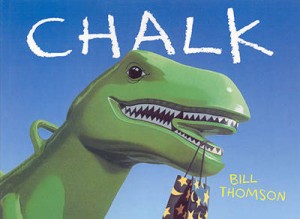Got a new device? Play with “Chalk”!
If you were lucky enough to get an iPad, a Kindle, or some other fun e-gizmo this holiday season, and you’d like your kids to use it for more than just throwing (understandably) angry birds, get yourself some Chalk.
Chalk by Bill Thomson is a visually stunning wordless picture book available as a Kindle e-book. (If you have a tablet or an iPad, you can download the Kindle app for free and read Kindle books – cool, huh?) Three children find a bag of chalk on a playground. The things they draw come to life. When one of the children draws a dinosaur, how will the children stop it?
Wordless books like Chalk are a great choice for young readers, and not just because they can “read” the pictures to get the whole story. When children read a wordless book with adults, typically the language the adults use to describe what is happening in the illustrations is of a more complex nature than the sentences and vocabulary usually found in picture books for young ones. (Want to know more? Read my article about wordless picture books for ReaderKidZ.com) So a wordless book can actually work well to teach the Common Core State Standard of Craft & Structure. I love that Chalk offers a great opportunity for problem-solving. When the dinosaur comes to life on the playground in the story, you can ask your young readers, “What would you do?” Kids can brainstorm how they’d solve the problem and discuss Thomson’s solution – the child who drew the dinosaur draws a rain cloud, which becomes real and washes all the chalk (including the dinosaur) away. Talk through the problem and the solution, the beginning-middle-end, and you’re hitting Key Ideas and Details as well!
After you’ve enjoyed Chalk on your device, pair up students and have them sit back to back. If you have a classroom set of iPads, you can use a free drawing app like My Blackboard, or you can go old-school and use real chalk and construction paper, dry erase markers and white boards, etc. Have each student draw something that, if it came to life, would cause a huge problem. Then, students swap pictures and draw something that can then solve that problem.
So, tech it up with your students with the Kindle book and a fun, free app, or embrace the paper and get the book from your local library, but either way, don’t miss out on Chalk!
For more information, please visit billthomson.com.
Read More
Looking for the Helpers in a Time of Need
 I haven’t known what to say since the shooting at Sandy Hook Elementary School – there are no words for this tragedy. I have held my own children tighter, cried for the grieving families, and given thanks for the amazing teachers in our lives. Once again I find myself turning to Jean Gralley’s beautiful book, The Moon Came Down on Milk Street. I wrote about this book after the shooting in the movie theater in Aurora, Colorado. I’m reposting the information, with hopes that Jean’s words of wisdom may help you and your children to focus your attention on the helpers in times of need.
I haven’t known what to say since the shooting at Sandy Hook Elementary School – there are no words for this tragedy. I have held my own children tighter, cried for the grieving families, and given thanks for the amazing teachers in our lives. Once again I find myself turning to Jean Gralley’s beautiful book, The Moon Came Down on Milk Street. I wrote about this book after the shooting in the movie theater in Aurora, Colorado. I’m reposting the information, with hopes that Jean’s words of wisdom may help you and your children to focus your attention on the helpers in times of need.
What do we tell our children when these tragedies occur? We shield them as much as we can, but too often our kids overhear more than we’d like. How do we find the words that can make sense of the senseless?
I turned to my wise author/illustrator friend, Jean Gralley, for advice. She wrote what one reviewer called, “perhaps the best ‘crisis’ book ever published” for children: The Moon Came Down on Milk Street.
“Bad things happen in this world,” Jean wrote. “We know it; kids know it, too. When adults side-step a necessary conversation about this, lie about it or pretend it isn’t so, children realize we are being un-truthful and our discomfort only adds to their anxiety. (After Sept. 11) I instantly wanted to write and illustrate a picture book that allows adults and children a point of view and a “way in” to that conversation.
In this simple story an unnatural event gently takes place: the moon slowly, softly falls out of the sky onto a city street. When the narrator asks, “Who will make this right again?” Various voices answer, “I will!” and “We will!” and over the course of the story we watch the many helpers inventively and imaginatively repair the moon and set it back in the night sky.
In a time of natural disasters and emergencies of all kinds, kids worry. They worry about things that have happened and haven’t happened yet. It’s important we take the first steps and let them know we’re ready to listen to their thoughts, questions, and feelings, what makes them afraid. The Moon Came Down on Milk Street provides a way to enter that conversation. It also redirects the focus: yes, bad things sometimes happen. But look at all the good people coming together to make it better.”
Snuggle your children close and share The Moon Came Down on Milk Street. Talk about who came to help in the story: the doctors, nurses, fire chief, fire fighters and volunteers. Talk about who we count on in our own lives when we need help. We can focus on the one who committed an unimaginable crime, or we can be awed by the many who ran to stop the one, who helped those in need, and the brave heroes who put themselves in harm’s way to shield others.
For more information about Jean Gralley, please visit: www.jeangralley.com.
Read More
Max’s Castle
 Let me make it easier for you this holiday season, because I know how it is. You want to buy a book for a child for the holidays, but you think they’d probably like a toy better, but you don’t want to give plastic junk, and yet do kids even like educational toys? Do you give the kid an abacus and watch that smile dissolve, or do you give in and buy a lead-coated choking hazard that promotes violence and unhealthy body images?
Let me make it easier for you this holiday season, because I know how it is. You want to buy a book for a child for the holidays, but you think they’d probably like a toy better, but you don’t want to give plastic junk, and yet do kids even like educational toys? Do you give the kid an abacus and watch that smile dissolve, or do you give in and buy a lead-coated choking hazard that promotes violence and unhealthy body images?
Get Max’s Castle written by Kate Banks and illustrated by Boris Kulikov along with wooden letter blocks, a game of Scrabble, or Bananagrams and everyone’s happy! If you have an iPad, tech it up for free by downloading the free Magnetic Letters app to play along while you read!
Max’s Castle is full of imagination and creative problem-solving, along with letter recognition and spelling. I love the way Banks and Kulikov show that switching a few letters changes words. Max and his brothers use alphabet blocks to build a castle. Kulikov does a fantastic job with letter arrangement: Max is in the MOAT hanging onto a block that is angled with an M and a B when Benjamin says they need a BOAT. The boys use the letter blocks to solve problems, like when the ADDER that is literally “in” the DARK DUNGEON (Banks capitalizes the words the boys have built with blocks) is causing problems, the boys take the L from the BUGLE to make the ADDER a LADDER.
Once you share Max’s Castle with that lucky kid or with your lucky students, give the kids letter blocks or Scrabble tiles or the iPad with the Magnetic Letters app to play with and rearrange! You can let students explore independently, or give challenges, like “Here comes a SNAKE ready to attack – what could you make to solve the problem?” Kids can switch out letters to make a RAKE to shoo away the snake, or TAKE it to the woods, or give it a SNACK to eat instead of eating you, etc. Encourage students to see if they can make the word look a bit like the object it represents, like Kulikov did, or use the blocks or tiles to build a structure like Max and his brothers did. Kids will build upon the Common Core State Standards of Print Concepts, Phonological Awareness, and Phonics and Word Recognition while they build fine motor skills. You’ll be the hero of the holidays!
Read MoreStay: The True Story of Ten Dogs
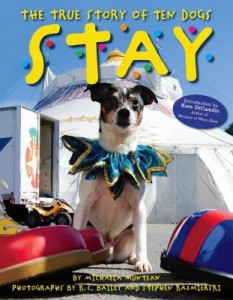 ‘Tis the season for gift-giving and for “best of the year” lists. The New York Public Library put 100 terrific titles on their Children’s Books 2012 list, including my pick for Most-Heart-Warming-Non-Fiction-Book: Stay: The True Story of Ten Dogs by Michaela Muntean with photographs by K. C. Bailey and Stephen Kazmierski.
‘Tis the season for gift-giving and for “best of the year” lists. The New York Public Library put 100 terrific titles on their Children’s Books 2012 list, including my pick for Most-Heart-Warming-Non-Fiction-Book: Stay: The True Story of Ten Dogs by Michaela Muntean with photographs by K. C. Bailey and Stephen Kazmierski.
Luciano Anastasini needed a second chance. He was a circus acrobat, from a long line of circus performers, until the day he fell fifty feet from the high wire. His body eventually healed, but he could no longer perform his old routines. He decided to train dogs for a new act, and since he was hoping for a second chance, he chose dogs who needed a second chance as well.
Bowser ended up at the pound because he was always stealing food from his owner’s table. Stick was a stray. Penny spun madly in circles, Cocoa was a digger, Tyke did the opposite of what he was told to do. Luciano took the dogs in and taught them to do fantastic, funny tricks. As the news spread about Luciano’s success with “hopeless” dogs, people brought him more dogs who needed a second chance: E-Z, Meemo, Sammy, Free, and Rowdy. Together Luciano Anastasini and his Pound Puppies have entertained circus crowds across the country. Muntean writes, “Sometimes a dog and a person will find each other at just the right moment – a moment when they need each other more than either could ever imagine.”
Share Stay: The True Story of the Ten Dogs with your students and discuss how Luciano turned each dog’s “flaw” into a strength in his act. (You’ll hit the Common Core State Standard of Key Ideas and Details, and hopefully have a wonderful class discussion on how our own flaws can become strengths, too.) Because it is the holiday season, consider making a craft that benefits shelter dogs. I love these easy, braided ropes you can make from upcycled old shirts. You’ll teach your students more than just informational reading skills; you’ll teach them that they can help make the world a better place.
Read More“Brothers at Bat” is Notable!
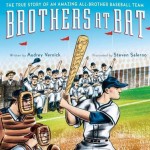 After a solid month of all the members of my household taking turns being sick (seriously, we dubbed our home “Contagion Manor”), I was so glad to return to work and see some of my favorite books on the New York Times Notable Children’s Books of 2012 list. I cheered when I saw on the Picture Book list a title by one of my author-friends, Audrey Vernick (remember her fantastic book Is Your Buffalo Ready for Kindergarten? I know, I loved it, too!) And then I realized that Brothers at Bat is the only non-fiction picture book on the list. I read lots of picture books to kids, and I’m trying to work at least one informational book into each reading. The best way to improve reading comprehension of information is to immerse our kids in interesting informational books. So if you’re on the lookout for fantastic non-fiction, here’s the most Notable of the 2012 bunch!
After a solid month of all the members of my household taking turns being sick (seriously, we dubbed our home “Contagion Manor”), I was so glad to return to work and see some of my favorite books on the New York Times Notable Children’s Books of 2012 list. I cheered when I saw on the Picture Book list a title by one of my author-friends, Audrey Vernick (remember her fantastic book Is Your Buffalo Ready for Kindergarten? I know, I loved it, too!) And then I realized that Brothers at Bat is the only non-fiction picture book on the list. I read lots of picture books to kids, and I’m trying to work at least one informational book into each reading. The best way to improve reading comprehension of information is to immerse our kids in interesting informational books. So if you’re on the lookout for fantastic non-fiction, here’s the most Notable of the 2012 bunch!
Brothers at Bat: the true story of an amazing all-brother baseball team is written by Audrey Vernick and illustrated by Steven Salerno. In 1938, the twelve Acerra brothers formed their own semi-pro baseball team. With their dad as their coach, the brothers went on to win league championships four times, and earned a place in the Baseball Hall of Fame as the longest-playing all-brother baseball team. Salerno’s art perfectly captures the feel of the 1930s and 1940s. I love the photo at the end of the book showing all the brothers in uniform.
More than just a book about an interesting bit of baseball trivia, the heart of this story is how the brothers were a team for life, both on and off the field. “As the younger brothers grew up,” Vernick writes, “the older ones shared playing time.” When Alfred loses an eye due to a bad bounce of a baseball, his brothers work with him so he can rejoin the team. “He was a pretty good catcher for a guy with one eye,” one brother says. You can discuss with your students all the examples of teamwork in this book to hit the Common Core State Standard of Key Ideas and Details. Talk about teamwork in your classroom. Your students can each make a “baseball” card for themselves, and even team uniforms with white t-shirts and Sharpie markers! Take your students outside for a game of catch with the little bouncy balls from the dollar store. You’ll build hand-eye coordination, cooperation skills, and a sense of teamwork in your classroom. Play ball!
Audrey Vernick has a curriculum guide with lots of discussion questions and ideas on her website: audreyvernick.com. On Steven Salerno’s website you can see some of the illustrations for this book in process: stevensalerno.com.
Read More
What To Do With All That Halloween Candy: Try The Great Graph Contest!
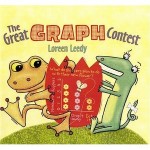 When I was a kid, my brother and I would empty out our bags after trick-or-treating on Halloween and divide the candy into piles: lollipops, bubble gum, candy we were willing to trade, favorites that would be hoarded, etc. I kept careful count of how many of each of my favorites I had, to make sure I’d know if one went missing (my brother was sneaky.) If I’d only had access to The Great Graph Contest by Loren Leedy when I was little, I could’ve made the best kind of bar graph – a candy bar graph – and organized all my trick-or-treat information with real-life math practice.
When I was a kid, my brother and I would empty out our bags after trick-or-treating on Halloween and divide the candy into piles: lollipops, bubble gum, candy we were willing to trade, favorites that would be hoarded, etc. I kept careful count of how many of each of my favorites I had, to make sure I’d know if one went missing (my brother was sneaky.) If I’d only had access to The Great Graph Contest by Loren Leedy when I was little, I could’ve made the best kind of bar graph – a candy bar graph – and organized all my trick-or-treat information with real-life math practice.
In The Great Graph Contest by Loren Leedy, a toad and a lizard compete to see who can make the best graphs. Leedy introduces bar graphs, picture graphs, pie charts, and Venn diagrams simply and with a sense of humor. Your class can use the information on making graphs to practice math with a subject they will find inherently interesting – their candy.
So, share the book with your students (noting with pride how easily you are working the Common Core State Standard of Range of Reading into your curriculum.) Next, get your hands on some candy. You can have students bring in some from home, you can steal from your own kids’ Halloween stash, you can get an assorted bag from the store – if lots of candy in the classroom doesn’t sound like a sweet deal to you, have students just bring in wrappers.
Talk about the different kinds of graphs found in the book, and which would be best suited to organize information about your candy. Sort candies by color of wrapper, ingredients, by beginning letter, etc. Paste wrappers to make a picture graph, or create bar graphs if you have large amounts. Make Venn Diagrams for things like “candies with chocolate”, “candies with nuts” and which candies would be the union. Graphing candy makes for a sweet math activity!
For more information, visit Loren Leedy’s website at: lorenleedy.com.
Read MoreAbiyoyo and Abiyoyo Returns
 It’s almost Halloween, and you want a book to share with your students that will give them shivers, but not nightmares. Pull out these picture books about a scary giant and the clever little boy who defeats him, and you’ll be hitting the Common Core State Standard of Integrating Knowledge and Ideas while you thrill your listeners.
It’s almost Halloween, and you want a book to share with your students that will give them shivers, but not nightmares. Pull out these picture books about a scary giant and the clever little boy who defeats him, and you’ll be hitting the Common Core State Standard of Integrating Knowledge and Ideas while you thrill your listeners.
Inspired by a South African folktale, Abiyoyo is a storysong written by the folk music master Pete Seeger and illustrated by Michael Hays. A little boy is always in trouble for making noise with his music. His father is shunned by the neighbors for playing too many pranks, making things disappear with his magic wand. But when fearful Abiyoyo comes, the little boy sings until the giant falls down from dancing, and the father uses his magic wand to make Abiyoyo disappear.
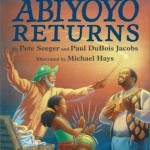 Compare this classic to its sequel, Abiyoyo Returns written by Pete Seeger and Paul DuBois Jacobs, and illustrated by Michael Hays. The little boy who made Abiyoyo disappear is now a grown man, and his town needs a giant’s help. With the help of the magic wand, Abiyoyo returns and the townspeople teach him to help rather than to harm.
Compare this classic to its sequel, Abiyoyo Returns written by Pete Seeger and Paul DuBois Jacobs, and illustrated by Michael Hays. The little boy who made Abiyoyo disappear is now a grown man, and his town needs a giant’s help. With the help of the magic wand, Abiyoyo returns and the townspeople teach him to help rather than to harm.
There’s a terrific “Reading Rainbow” video of Pete Seeger telling/singing the first book (available for free on Youtube) and an audio cd available as well. Share the audio recording of Abiyoyo along with the book so your students can listen to a master storyteller. (You’ll enjoy listening to him as much as your students do, and it’s amazing how listening to a different voice than the one they hear all the time can perk up ears during a read-aloud.) Before reading Abiyoyo Returns, predict with your students how the people will handle Abiyoyo when he comes back. Contrast how Abiyoyo is the problem in one story and the solution in the other.For a fun art extension, get dowels from the hardware store (you can find them for less than $1 – cut them in half and they’re even less expensive!) and decorate your own magic wands. If your students are plagued with Halloween wiggles, let them sing the Abiyoyo song and dance around until they fall down. When you wave your wand to magically transport students back to their seats, their Halloween wiggles will have vanished!
Read More



